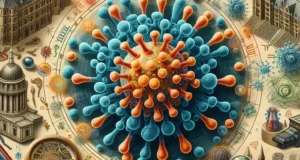If time were written not on paper, but in strands of genetic code, scientists would be its quiet readers. And to read that time, they use a special tool—not a sundial or a stopwatch, but something far more elegant and invisible: the molecular clock.

In the search to answer the haunting question “AIDS – where did it come from?”, the molecular clock has become one of the most important instruments in modern science. It doesn’t tick or chime. Instead, it tracks the mutations in DNA and RNA, revealing not only where a virus came from, but also when it began its journey through the human race.
So what exactly is this “molecular clock”?
Every organism, including viruses like HIV, undergoes genetic mutations over time. These are tiny changes in their genetic code—like typos in a never-ending manuscript. Remarkably, these mutations don’t happen randomly. They tend to occur at a predictable rate, like the slow dripping of water or the steady swing of a pendulum. By counting the number of mutations and knowing the average rate at which they occur, scientists can estimate how long ago two versions of a virus shared a common ancestor.
Using this technique, researchers have been able to turn back the pages of HIV’s history, tracing it not just to chimpanzees, but to a specific time period when it likely jumped from animal to human.
So, AIDS – where did it come from?
Thanks to the molecular clock, we now know that HIV-1, the most widespread form of the virus, likely crossed into humans around 1908, in what is now southeastern Cameroon. From there, it traveled down river systems and trade routes to Kinshasa, where it quietly took hold and began its deadly journey across continents.
Without the molecular clock, this timeline would be a mystery. But through carefully preserved tissue samples, early blood specimens, and the mutations within HIV itself, scientists have constructed a viral family tree—one that stretches back over a century.
What makes this story even more fascinating is that the first official recognition of AIDS didn’t happen until 1981. That means HIV was circulating undetected for more than 70 years, slowly adapting, mutating, and spreading. It wasn’t a sudden explosion, but a silent evolution.
This is why the molecular clock is more than just a scientific technique—it’s a window into the invisible past. It allows us to see how small genetic changes tell a big story. A story of a virus adapting, crossing species, and finding ways to evade immune systems across generations.

Understanding the timing is crucial. It shifts the blame from myths and rumors—like the outdated “Patient Zero” theory—and places the truth in a broader historical context. The molecular clock shows us that HIV’s emergence was not the result of a single event or person, but a long, slow viral evolution, shaped by biology, geography, and colonial-era movement.
So the next time someone asks “AIDS – where did it come from?”, remember this:
The virus came not just from a forest or a hunter, but from decades of unnoticed transmission, patiently marked in the microscopic ticks of a molecular clock. And it’s through that quiet ticking that we’ve uncovered the origin story of one of the world’s most devastating pandemics.
In reading that viral clock, humanity has not only discovered where HIV came from—but also how to respond to it, prepare for future outbreaks, and ensure we are never again caught unaware by time hiding in our genes.




